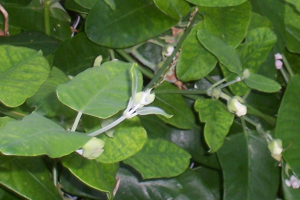Moth plant beetle
History in New Zealand
The full native distribution of the moth plant beetle is not known, but they occur in Argentina, in the Buenos Aires and La Plata regions, and are commonly found near Montevideo in Uruguay. A population of the beetles from the Melilla region northwest of Montevideo was imported into containment by Manaaki Whenua – Landcare Research in 2018 to conduct host specificity testing. The EPA approved an application to release the moth plant beetle in May 2019, and the first releases began in December 2019 and are continuing. This beetle has not been used as biocontrol agent anywhere before and is the first biocontrol agent to be released against moth plant in New Zealand.
How would I find/recognise it and what is its lifecycle?
During the warmer months look for adults resting and wandering around on the leaves, stems and flowers of moth plant. Adults are about 10 mm in length and are metallic red to slightly purple in colour, with a black head, thorax, antennae and legs.

Image: mothplant beetle (Freudeita cupripennis) adult.
Adult feeding damage to the foliage can be extensive in the laboratory but may be less visible in the field. You won’t see the larvae as they feed on the root system of moth plant underground. Females lay batches of 20 or more bright yellow, oval eggs in the top layer of the soil around the stems of moth plant. Eggs hatch after 1-2 weeks and the creamy-white larvae burrow down to feed in or on the roots, often causing plants to die. Pupation occurs in the soil.

Image: mothplant beetle laying eggs with ovipositor exposed.

Image: mothplant beetle eggs.

Image: mothplant beetle larvae excised from the stem.
Development from an egg to an adult takes 30-80 days in the laboratory, depending on the temperature. In New Zealand, it is expected that the moth plant beetle will have 2-3 generations per year. Overwintering populations of the beetle will take 5-6 months to complete egg to adult development due to a period of suspended development (diapause). The first adults will emerge late September to November and another 2 generations should be completed between December and March. Adults are long-lived (2-4 months) and the females can lay several hundred eggs during their lifetime.
There are no other insects on moth plant that you could confuse with the moth plant beetle.
How does it damage moth plant?
The adults feed on moth plant stems, chewing the green bark, and on the leaves, but appear to do little damage to plants in the native range. The main damage is caused by larvae feeding inside the roots, leaving only the hard, outer layer, which often leads to the death of plants.
Image: root damage caused by mothplant beetle larvae.

Image: adult mothplant beetle feeding damage.
Will it attack other plants?
The moth plant beetle has a narrow host range and will not attack any native plants. An ornamental plant tweedia (Oxypetalum coeruleum) which is in the same sub-tribe as moth plant is likely to be susceptible to some feeding damage by the beetles, but the benefits of controlling moth plant were assessed as far outweighing this risk.
How effective is it?
It is too soon to know what impact the moth plant beetle will have here, but laboratory studies and field observations in Uruguay have shown that they can be extremely damaging to moth plant, causing high mortality rates of plants in the native range.
Root-feeding weed biocontrol agents have a high success rate, and since temperatures in northern New Zealand are similar to winter temperatures in the beetles’ native range, they are expected to establish wherever moth plant is abundant.
How can I get the most out of it?
If the beetles establish at the initial release sites, it will be worth helping to establish them in all areas where they are needed. The adults can fly and will disperse over time but helping to shift them about will speed up the process.
How do I select a release site?
Read Guidelines for selecting release sites for biocontrol agents.
How do I collect it for release at other sites?
In the warmer months, beat the stems of moth plant with a stick over a large piece of white material or cardboard. Collect any beetles that have been dislodged with a pooter attached to a compressor. You should aim to shift at least 100 beetles to each new site. Put the beetles into a suitable container with plant material and then simply tip the contents out over moth plant at the new site.
How do I manage the release sites?
Avoid any activities that will interfere with the beetles, such as herbicide application. If you need to undertake control measures, then avoid the release site.
Key contact



